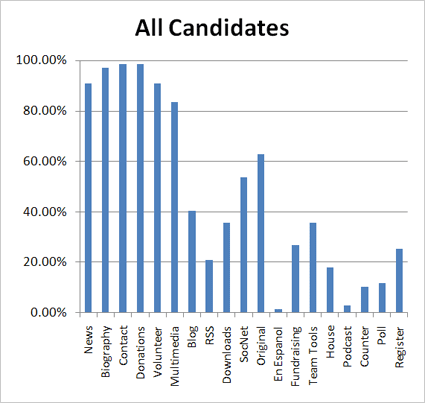We recently completed a study of the use of the Internet by 2008 candidates for the United States Senate. This report, which is a follow up to similar studies we conducted in 2006 and 2002, examines what features Senate candidates include on their campaign websites. You can read the full report outlining our methodology here.
The following chart shows the percentage of candidates using each feature we looked at.

Below are some of the more intriguing findings from the report:
- Incumbents are using the web more aggressively than they have in past cycles. In the 2002 and 2006 cycles, challengers tended to have more feature rich websites than incumbents. In 2008, there is no overall trend. Incumbents were more likely to have voter registration tools and multimedia content, while challengers were more likely to advertise presences on external social networks and to include house party functionality.
- There is no real difference in the way Republicans and Democrats are using their campaign websites. Republicans were more likely to have campaign blogs and multimedia sections, while Democrats were more likely to have team building tools. Usage of the other features was essentially identical.
- Many of the features being used to great effect by Presidential campaigns are not being used by Senate candidates. None of the sites reviewed in the study had a Barack Obama-style social network built into their site. In addition, features like house parties and real time counters (“money bombs”) that have been core features in many 2008 Presidential campaigns are not used to a great degree by Senate campaigns.
- Many candidates are advertising their presences on third-party social networks on their campaign websites. Over half of campaigns linked to presences on social networks such as Facebook, MySpace and YouTube.
- The number of campaign websites with blogs has increased greatly, from 23 percent of campaigns in 2006 to 40 percent in 2008. Interestingly, Republican candidates were more likely to have campaign blogs (48.4%) than Democrats (33.3%).
- Candidates this election cycle are utilizing multimedia (audio and video files) more than in previous years. In 2006, 54.5% of campaigns had multimedia on their websites, while in 2008 83.6% of campaigns host this kind of content.
- Some basic features were present on virtually every campaign website. Elements that were included on just about every site were News (91%), Biography (97%), Contact information (98.5%), Online Donations (98.5%) and a Volunteer Form (91%).
A link to the full report (as well as the 2006 report and the data sheet) is below, which also contains numerous graphs showing all the various information collected.
2008 Senate Study PDF
Check out our 2006 and 2002 studies.
While many members of TBG added insight and opinions during the course of the study, I would like to especially thank Todd Zeigler, Nate Schneiders, and Samantha Strauss for their contributions.
In the name of full disclosure, TBG does some work for the Republican Party and for a few Republican candidates, although it is not our primary focus. This is also mentioned in the study.
